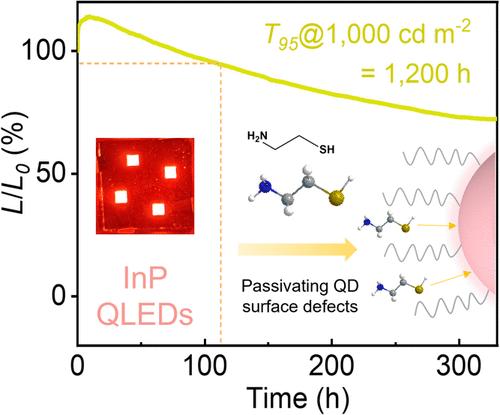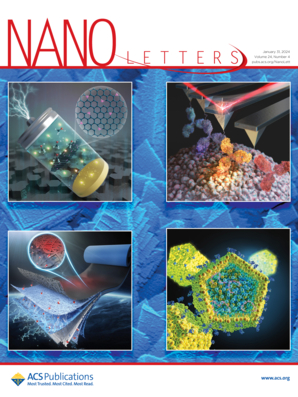Stable and Efficient Red InP-Based QLEDs through Surface Passivation Strategies of Quantum Dots
IF 9.1
1区 材料科学
Q1 CHEMISTRY, MULTIDISCIPLINARY
引用次数: 0
Abstract
Indium phosphide (InP) is a representative of environmentally friendly quantum dots (QDs), and quantum dot light-emitting diodes (QLEDs) based on InP QDs are prime candidates for next-generation display applications. However, there are numerous nonradiative sites on the surface of InP QDs, which compromise the operational stability of QLEDs. Herein, we employed cysteamine (CTA) molecules for post-treatment of QD films, effectively passivating surface defects and nonradiative sites, thereby enhancing stability. This treatment enabled a long T95 lifetime of over 1,200 h at an initial luminance of 1,000 cd m–2. Additionally, CTA-treated QDs induced the formation of an interface dipole, elevating the energy levels of QDs and reducing the injection barrier for holes. Moreover, the dipole moment at the interface hindered electron injection, achieving a more balanced carrier injection in the device. Consequently, we achieved a peak external quantum efficiency (EQE) of 21.21%.

基于量子点表面钝化策略的稳定高效红色inp基qled
磷化铟(InP)是环境友好型量子点(QDs)的代表,基于磷化铟QDs的量子点发光二极管(qled)是下一代显示应用的主要候选者。然而,InP量子点表面存在大量的非辐射位点,影响了qled的工作稳定性。本文中,我们使用半胱胺(CTA)分子对量子点薄膜进行后处理,有效钝化表面缺陷和非辐射部位,从而提高稳定性。这种处理使得T95在初始亮度为1,000 cd - m-2时的寿命超过1,200小时。此外,cta处理的量子点诱导了界面偶极子的形成,提高了量子点的能级,降低了空穴的注入势垒。此外,界面处的偶极矩阻碍了电子注入,使器件中的载流子注入更加平衡。因此,我们实现了21.21%的峰值外量子效率(EQE)。
本文章由计算机程序翻译,如有差异,请以英文原文为准。
求助全文
约1分钟内获得全文
求助全文
来源期刊

Nano Letters
工程技术-材料科学:综合
CiteScore
16.80
自引率
2.80%
发文量
1182
审稿时长
1.4 months
期刊介绍:
Nano Letters serves as a dynamic platform for promptly disseminating original results in fundamental, applied, and emerging research across all facets of nanoscience and nanotechnology. A pivotal criterion for inclusion within Nano Letters is the convergence of at least two different areas or disciplines, ensuring a rich interdisciplinary scope. The journal is dedicated to fostering exploration in diverse areas, including:
- Experimental and theoretical findings on physical, chemical, and biological phenomena at the nanoscale
- Synthesis, characterization, and processing of organic, inorganic, polymer, and hybrid nanomaterials through physical, chemical, and biological methodologies
- Modeling and simulation of synthetic, assembly, and interaction processes
- Realization of integrated nanostructures and nano-engineered devices exhibiting advanced performance
- Applications of nanoscale materials in living and environmental systems
Nano Letters is committed to advancing and showcasing groundbreaking research that intersects various domains, fostering innovation and collaboration in the ever-evolving field of nanoscience and nanotechnology.
 求助内容:
求助内容: 应助结果提醒方式:
应助结果提醒方式:


